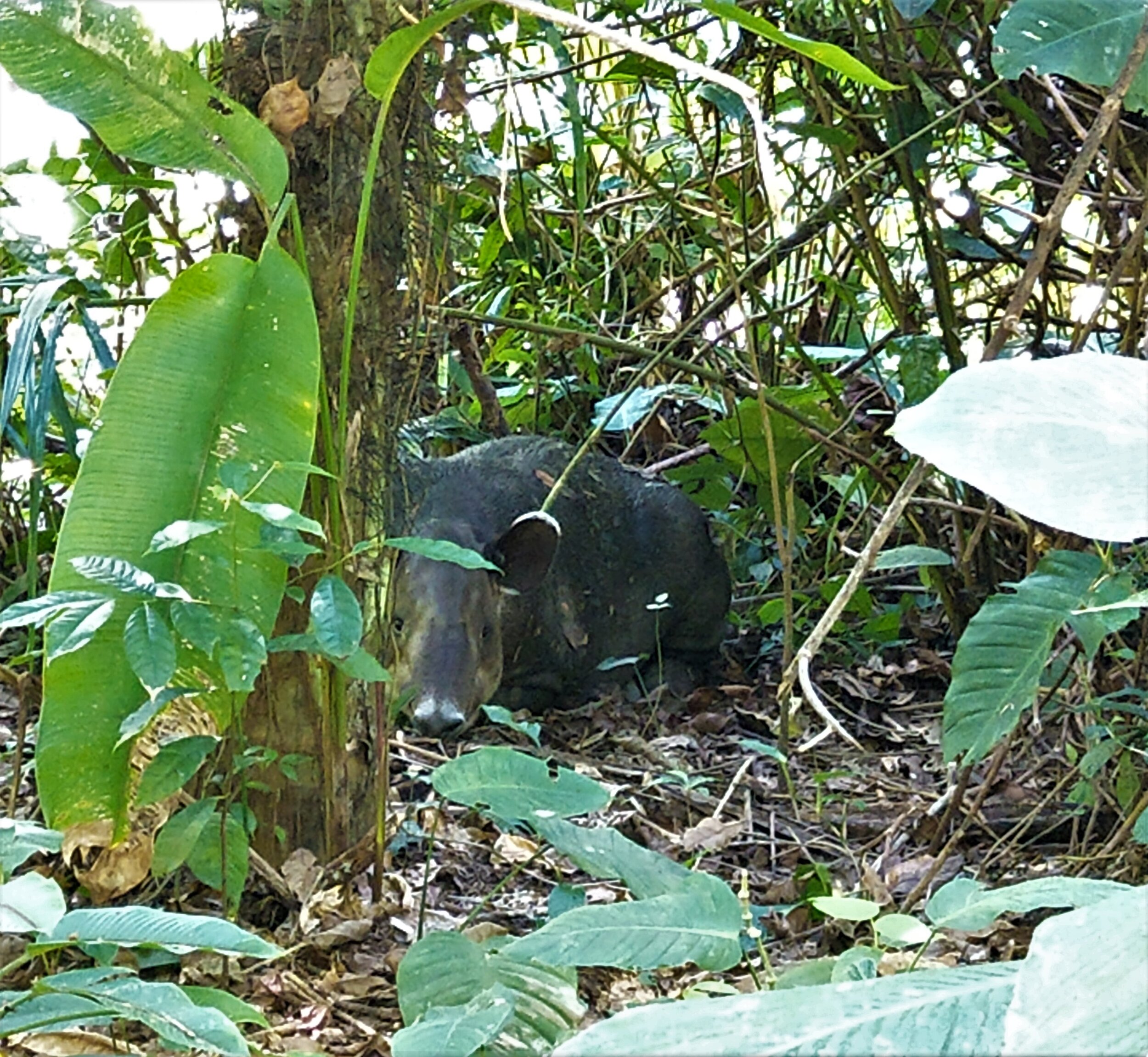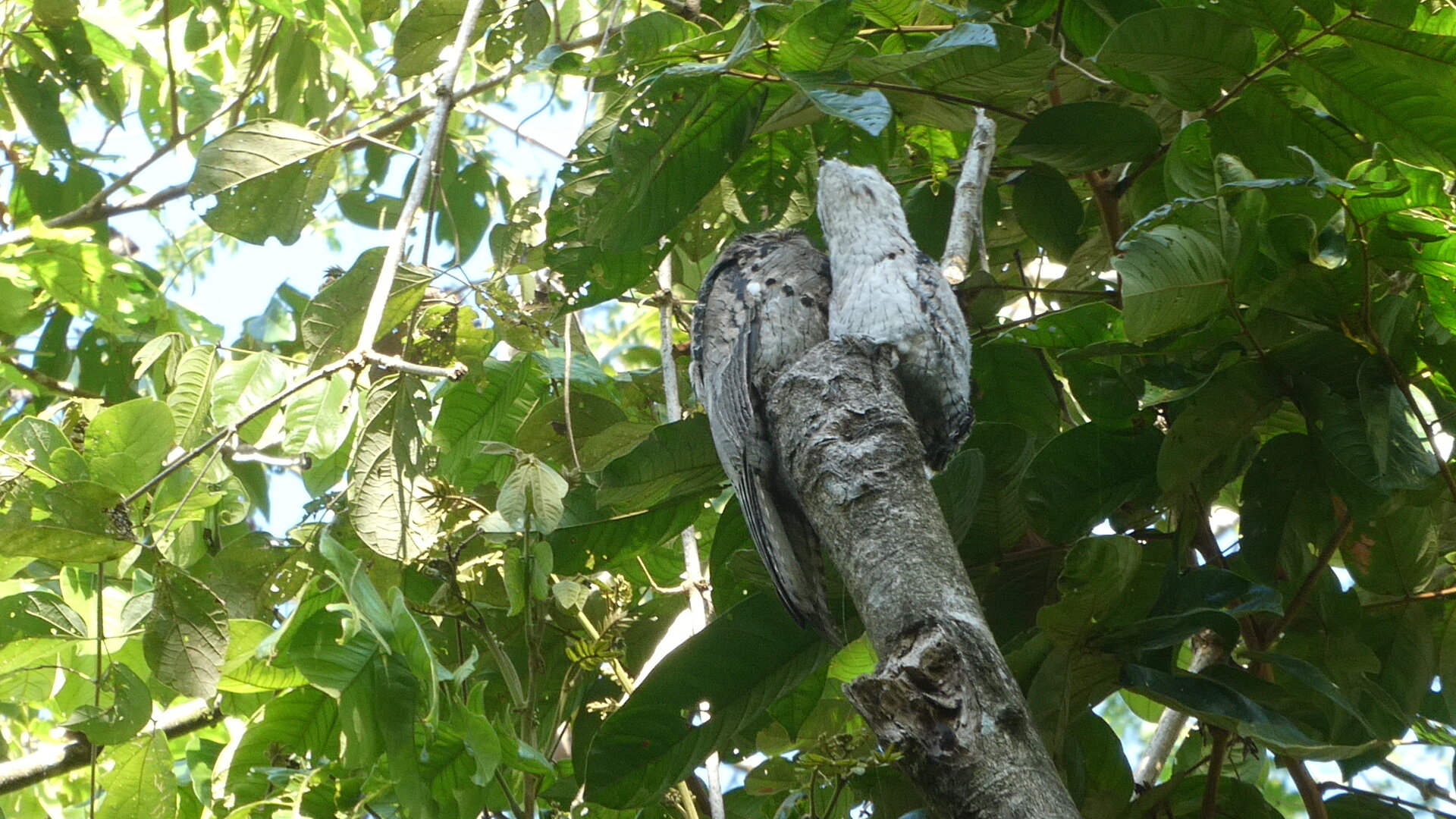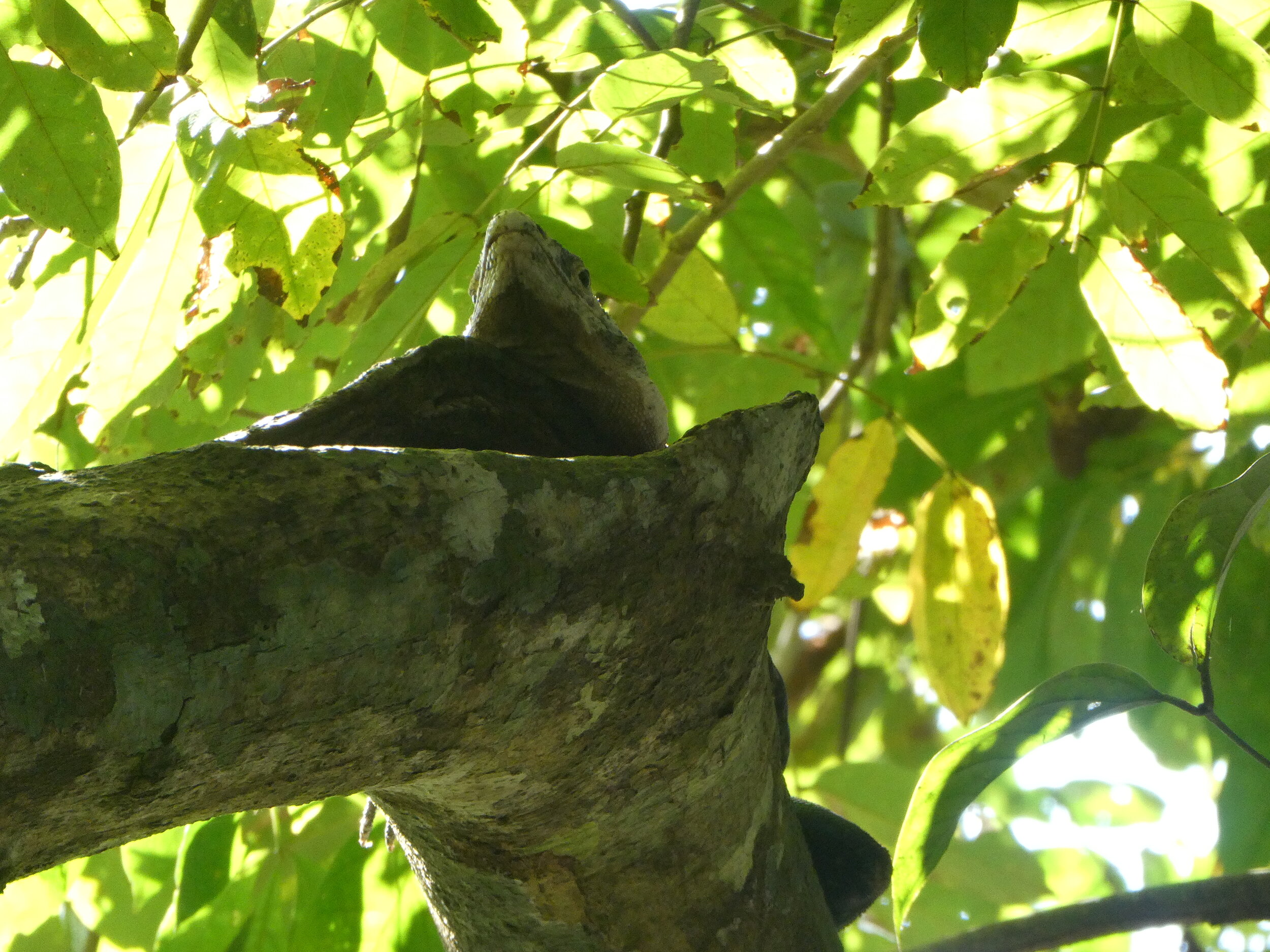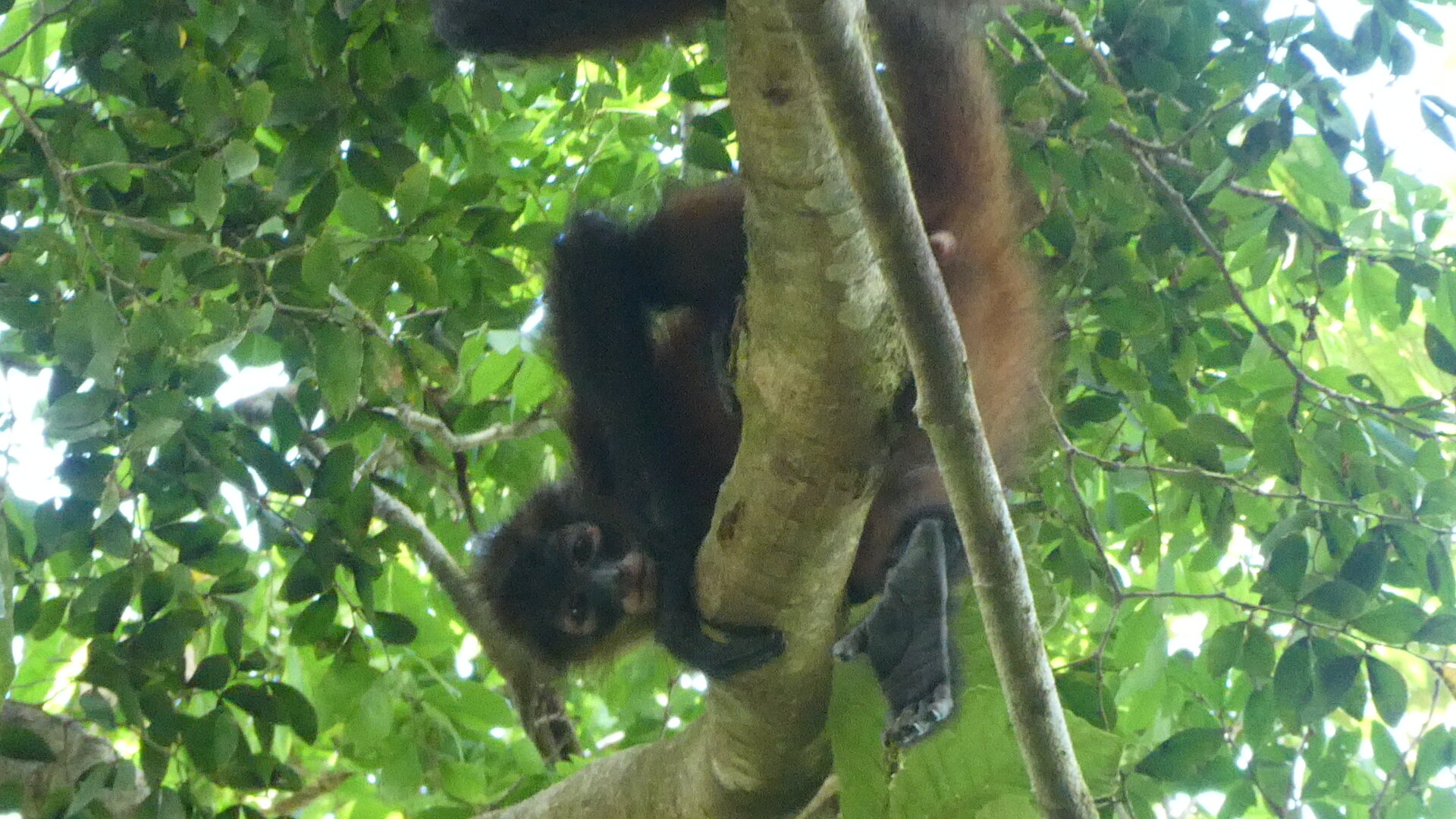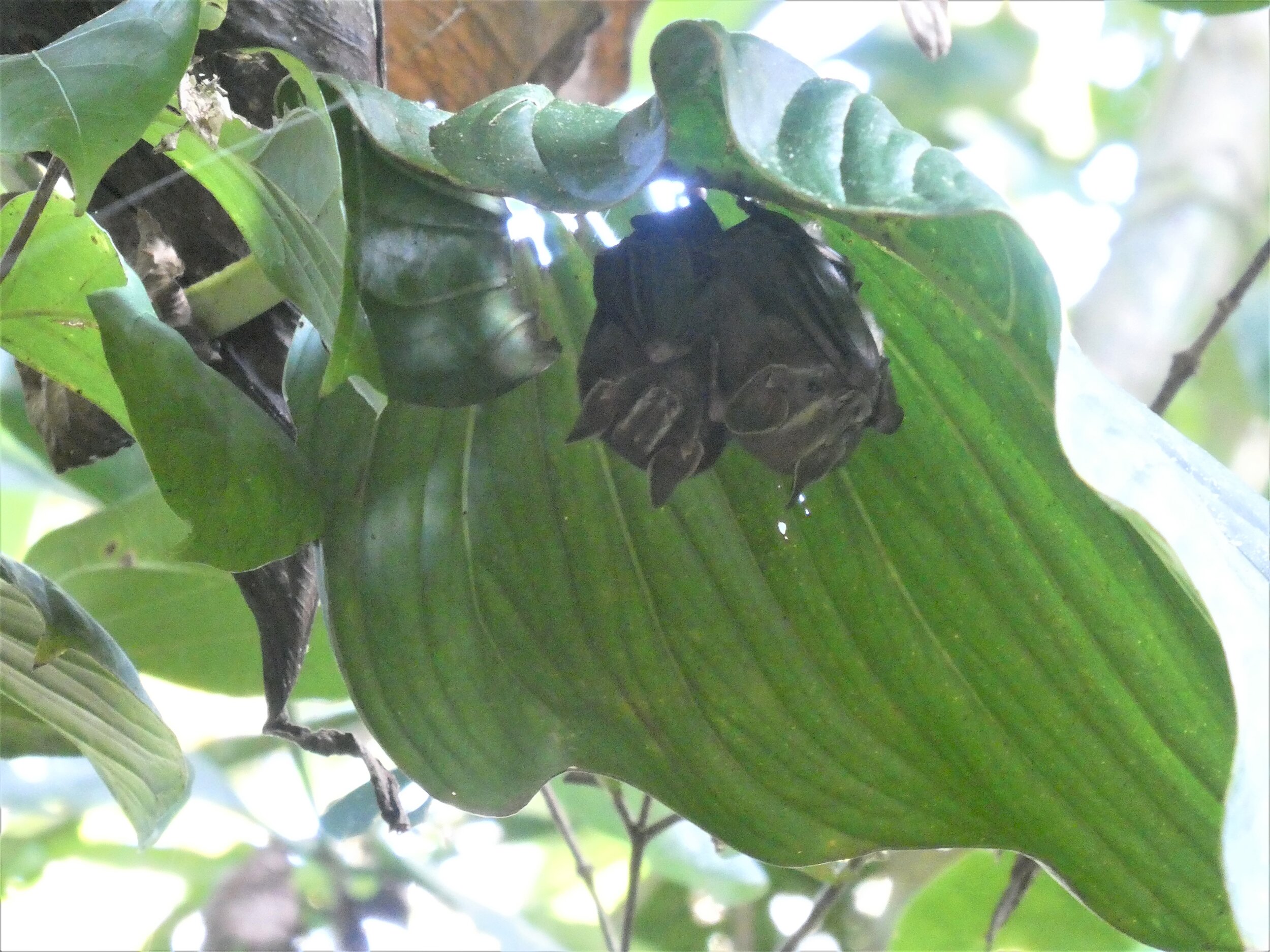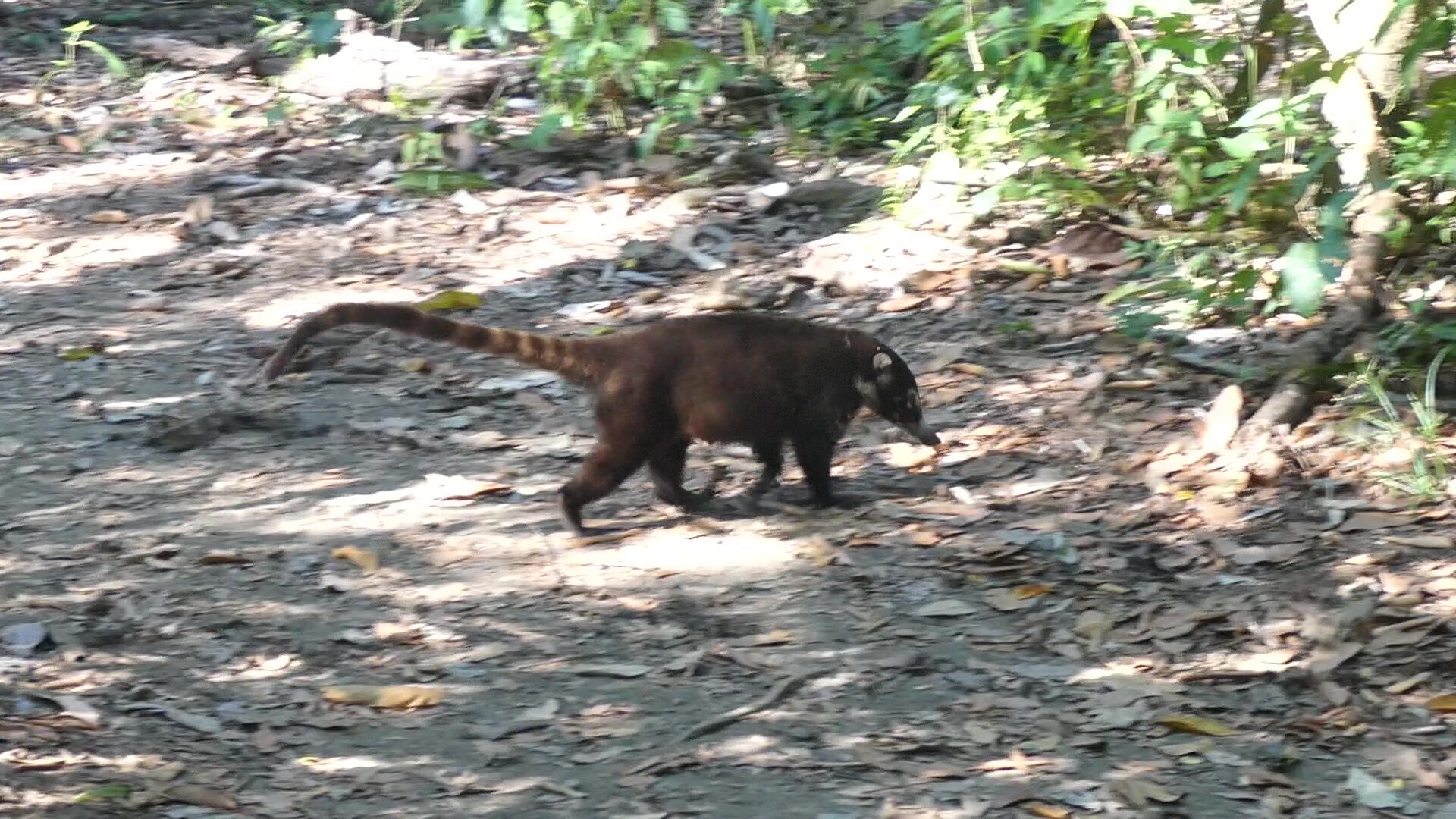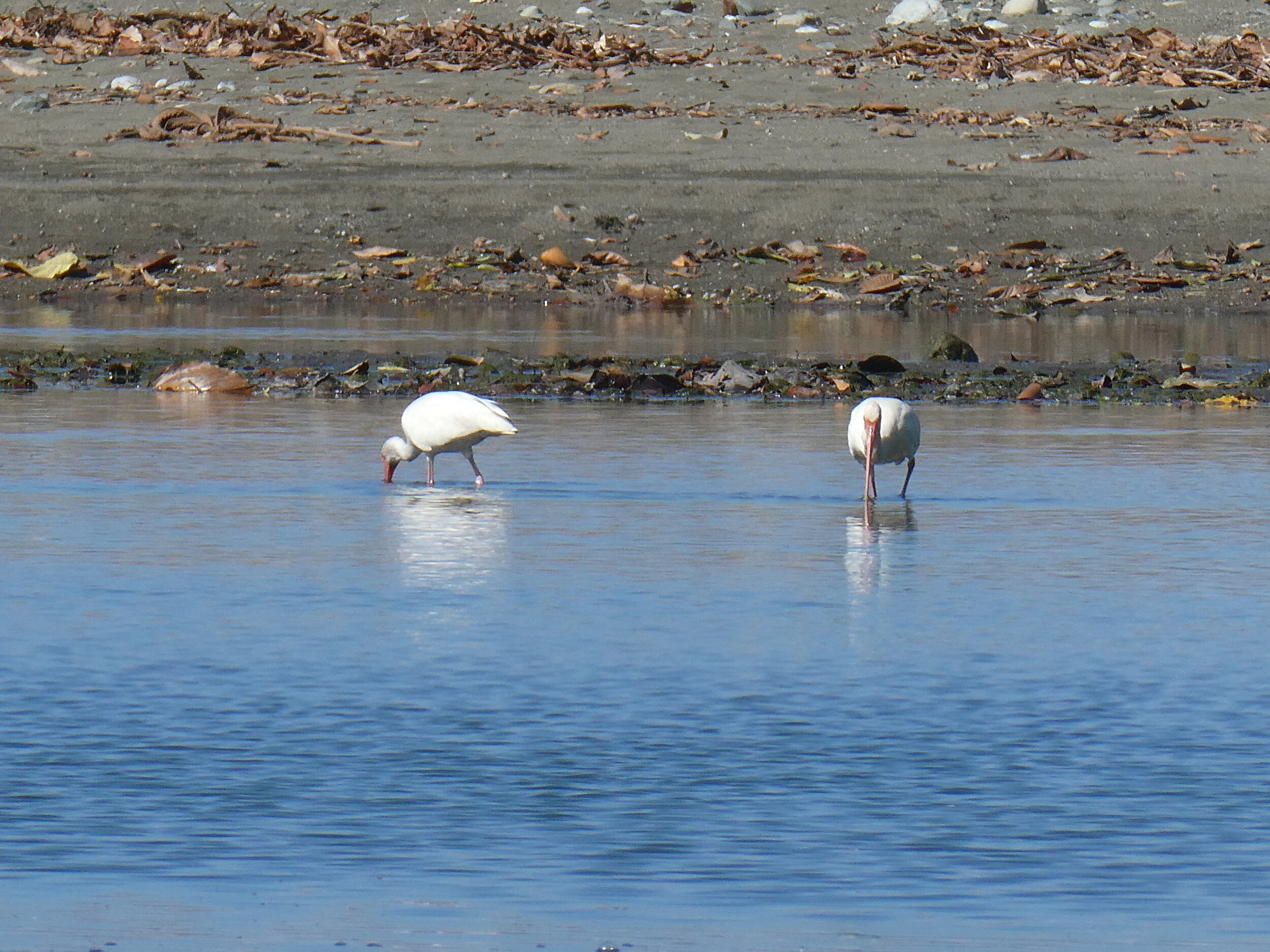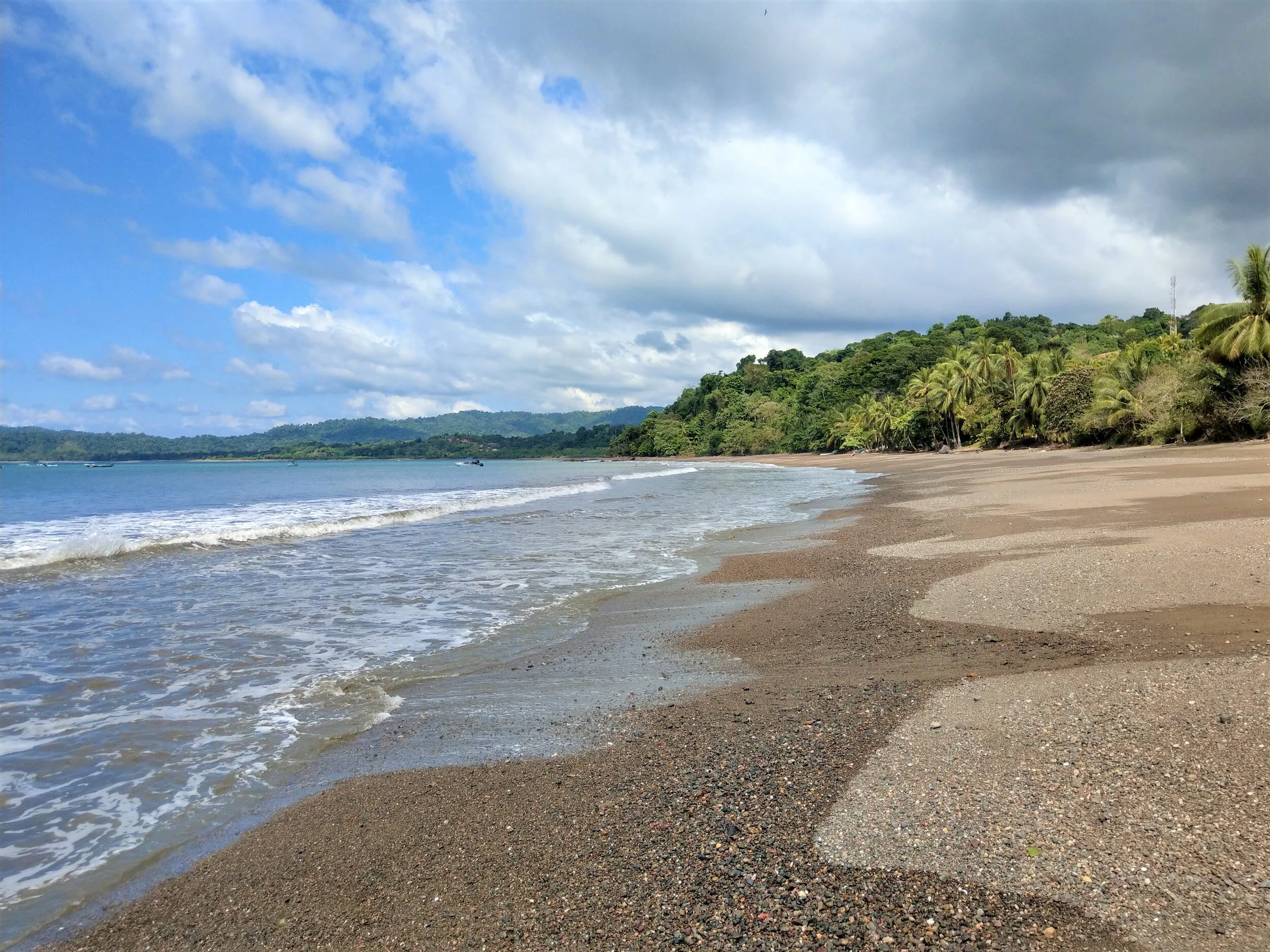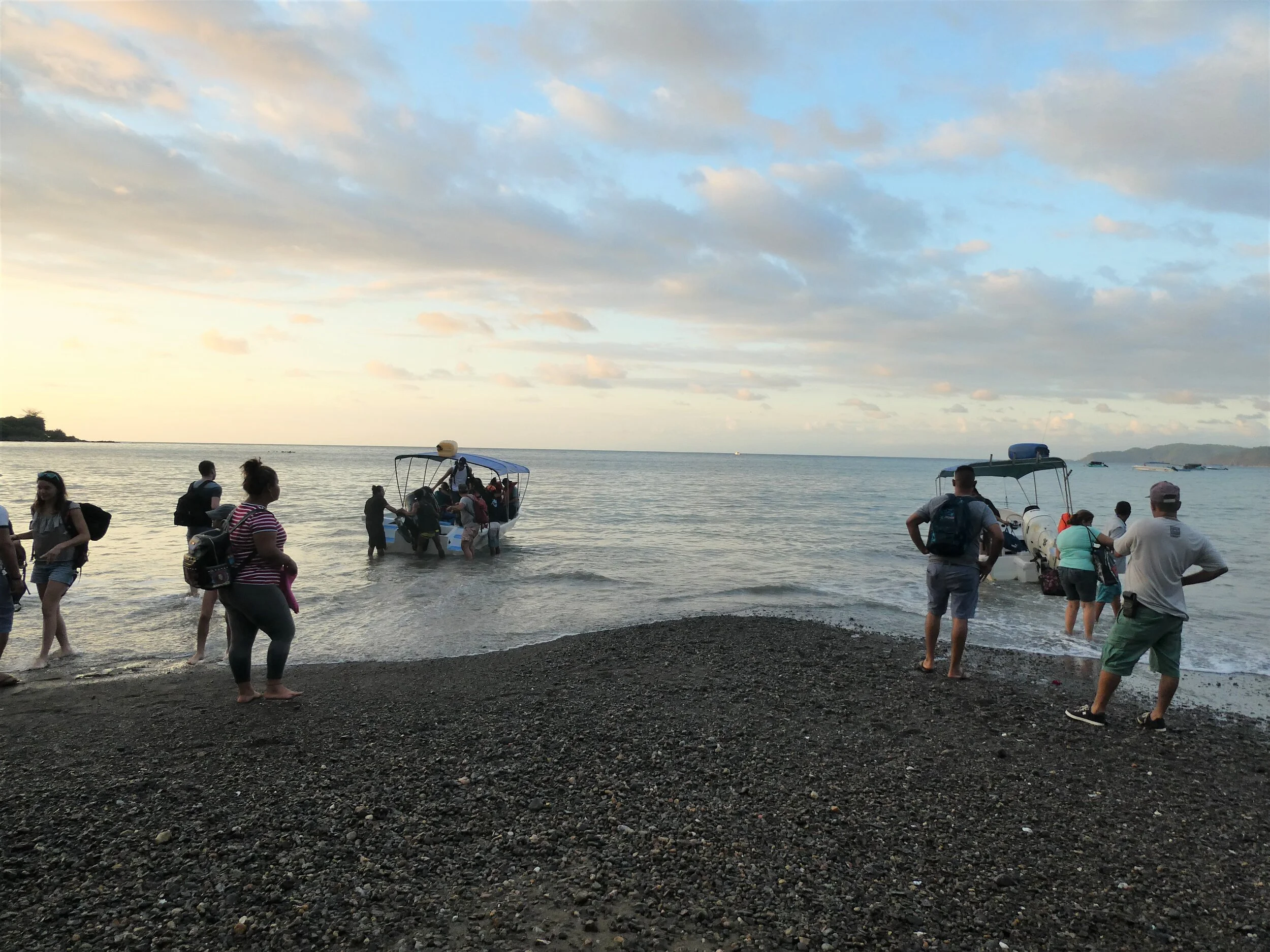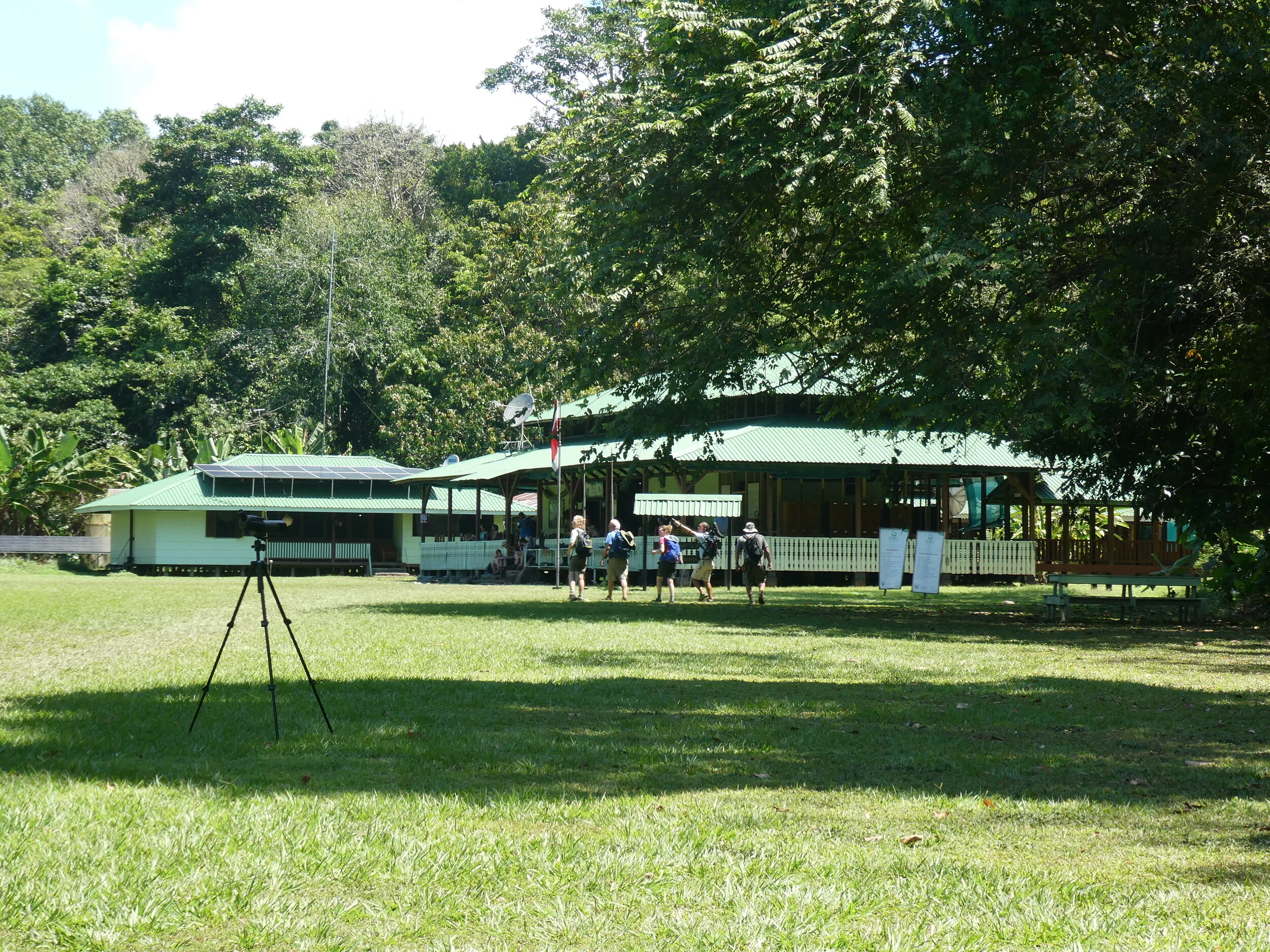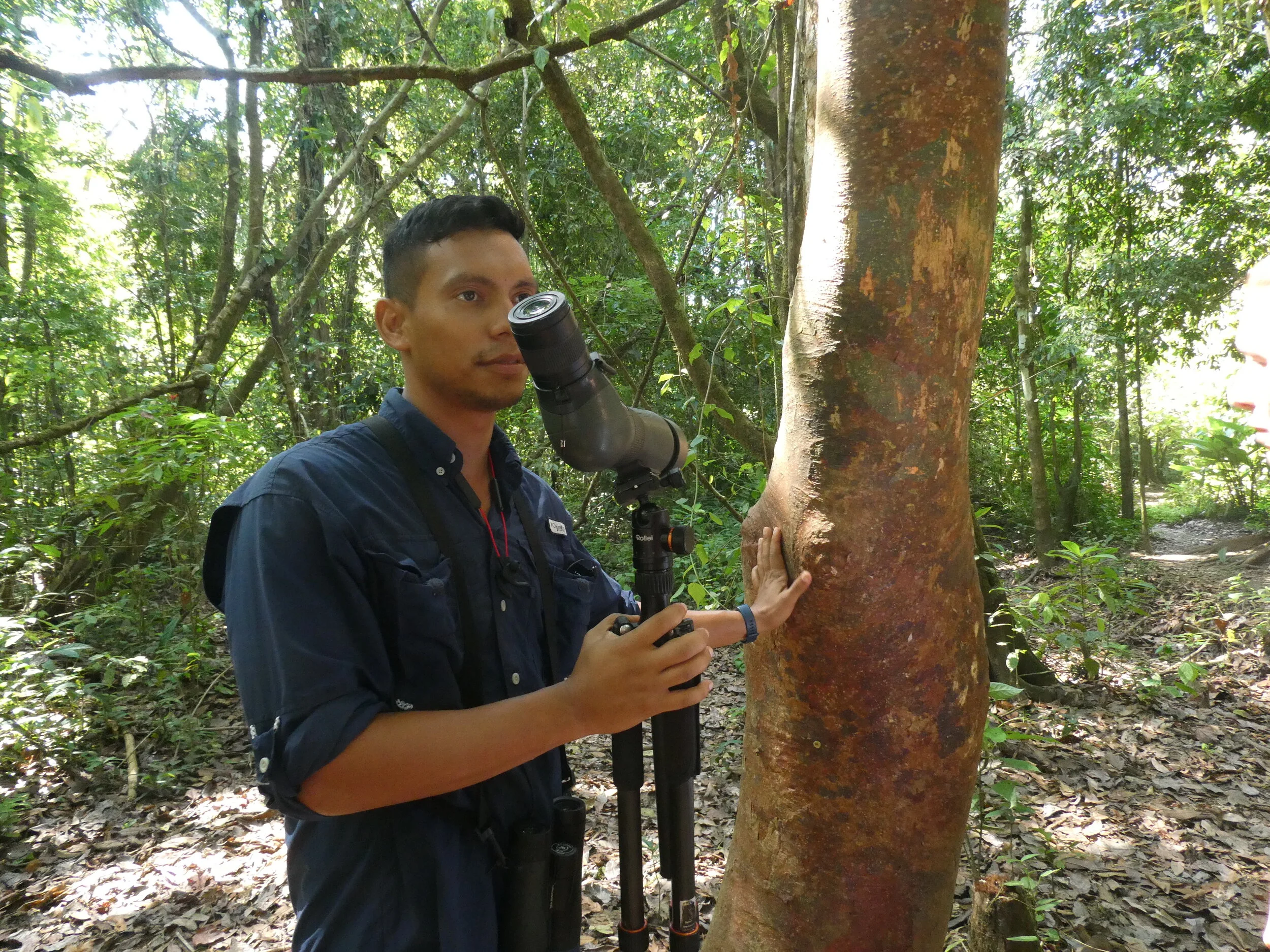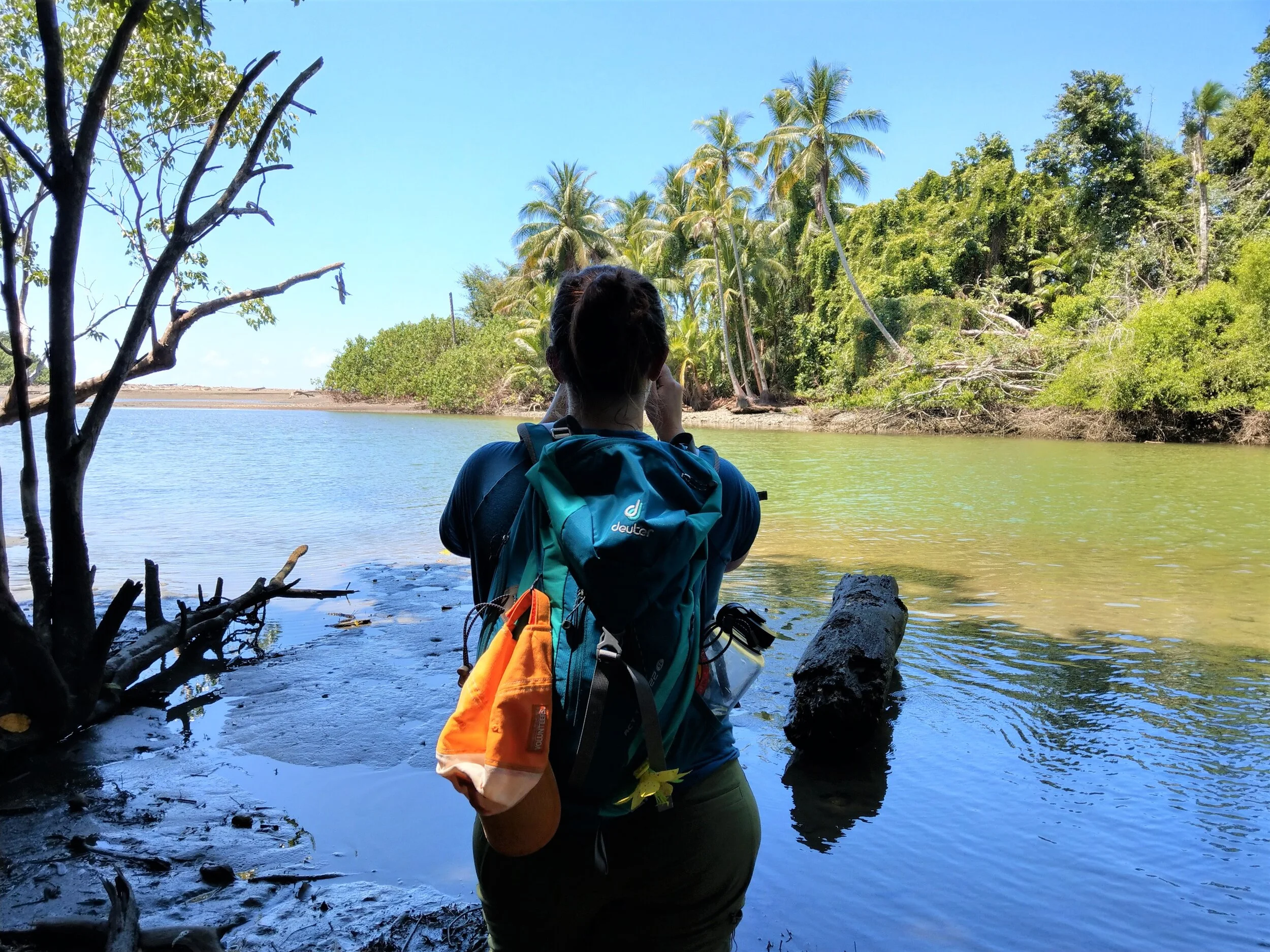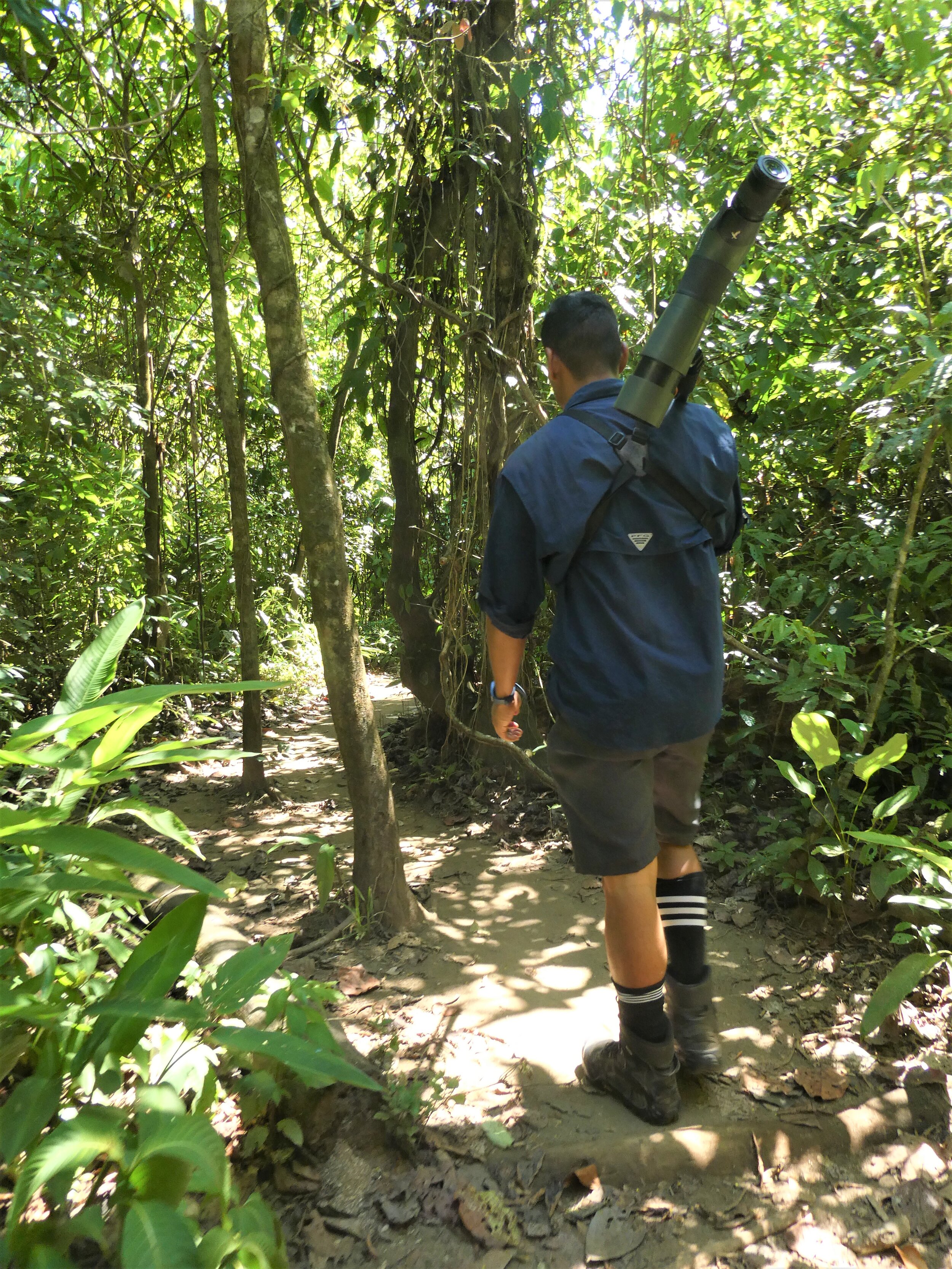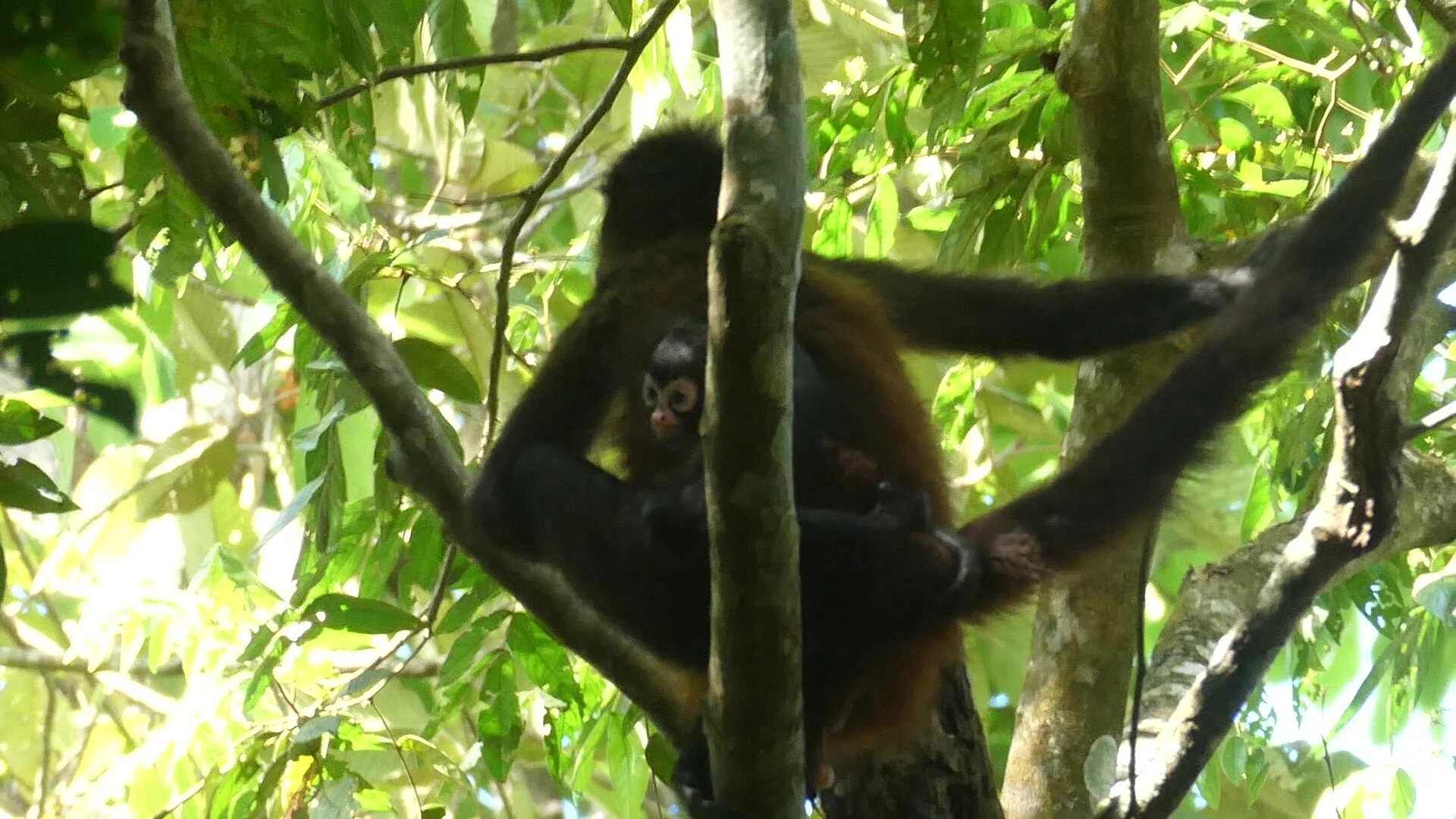How to Visit Corcovado National Park in Costa Rica
Imagine gliding on boat through the ocean alongside beautiful beaches lined with tall, coconut-filled palm trees, feeling a warm tropical breeze run through your hair. The boat docks on a remote golden beach about an hour into your journey, bringing you right to where the jungle literally meets the sea. You’re greeted by the squawk of a pair of scarlet macaws as they fly overhead, welcoming you to this remote and untouched paradise. As you go deeper into the rainforest, you hear the distant chilling roar of the howler monkeys, and the loud buzzing of cicadas fills your ears. A tiny coati runs across your path up ahead. You spot a sloth hanging lazily in the treetops above you, as you search for the rare Baird’s Tapir that can often be spotted here.
Ok, this is not a dream. It’s real life. And it’s what you can expect with a visit to Corcovado National Park in Costa Rica.
Corcovado National Park is one of Costa Rica’s most remote parks, located in the southwestern corner of the country on the remote Osa Peninsula. This park protects the largest remaining primary rainforest on Central America’s Pacific Coast and is home to rich biodiversity, including some of Costa Rica’s most endangered and rare species.
Comprising over 160 square miles, the park was established in the 1970’s to protect against the spread of illegal gold mining and logging operations. Today, it remains a nearly untouched wilderness, and arguably the best place in Costa Rica to observe wildlife, making a visit to Corcovado a must for nature enthusiasts.
Sounds awesome, right? The catch? Visiting Corcovado does require a bit of an adventurous spirit and some advanced planning and effort to make this dream a reality.
In this guide, we will walk you through everything you’ll want to know about how to plan a visit to Corcovado National Park…how to get there, where to stay, what to expect, and much more. When we were looking for information about visiting Corcovado National Park, we found bits of useful information here and there but struggled to find a single source of complete information, so our goal here was to make the most comprehensive guide that we could with all the information in one place to help you plan an amazing visit to Corcovado.
So, let’s do this!
Article Contents
Why visit Corcovado National Park?
What kind of wildlife is in Corcovado?
How to visit Corcovado: An overview
How to get to Corcovado via Drake Bay or Puerto Jimenez
Ranger stations in Corcovado
Types of tours to Corcovado
Day tours to Corcovado
Overnight tours to Corcovado
Multiday tours to Corcovado
Which Corcovado tour should you choose?
Things to know about Corcovado before you visit
Best time to visit Corcovado
What to pack for Corcovado
Want to save this article for later? Pin it and come back any time!
Why Should You Visit Corcovado National Park?
If we haven’t already convinced you that a visit to Corcovado is a must-do in Costa Rica, let us try some more.
As one of the largest lowland tropical rainforests in Central America, the park makes up almost half of the entire Osa Peninsula. It’s a truly remote region of the country that remains mostly untouched, giving you the chance to observe wildlife it its genuinely natural habitat.
And, my friends, you will certainly see some wildlife…Corcovado National Park was famously dubbed by National Geographic as being “the most biologically intense place on earth”. Yes, on earth! It’s kind of like visiting a mini version of the Amazon, right in Costa Rica! You would be hard pressed to find any place else of similar size that matches its incredible diversity.
During a visit to Corcovado, you’ll also wander through several of the parks 13 ecosystems, which include beach, freshwater swamps, primary and secondary rainforest, mangroves, streams, and lagoons.
What kind of wildlife will you see during a visit to Corcovado?
While there is never a guarantee of sighting any specific kind of wildlife during a visit to Corcovado, it’s virtually a guarantee that you will see wildlife of some sort, and plenty of it!
Here’s just a sampling of what we saw on our day tour in Corcovado National Park!
Here are some fun facts about the diversity and wildlife in Corcovado:
Corcovado hosts 3% of the world’s biodiversity and half of Costa Rica’s alone. It’s home to 140 species of mammals, nearly 400 species of birds, over 100 species of amphibians and reptiles, 500 species of trees, and 10, 000 species of insects!
In Corcovado, you can find all four species of sea turtles that nest along Costa Rica’s Pacific Coast, 2 and 3 toed sloths, anteaters, tamanduas, coatis, crocodiles, caimans, lizards, toucans, tree frogs, and the largest and healthiest population of scarlet macaws in Central America.
The park is the only place in the country where you can find all four of Costa Rica’s monkeys in one place (howler, squirrel, spider and white-faced capuchin monkeys).
It’s even home to five species of big cats, including the jaguar and puma, although these are nocturnal and incredibly rare to find. Our guide told us jaguars have only been spotted on strategically placed cameras and he has not known anyone to see one in person (and I am not sure we would want to!).
Corcovado is also a good place to find large populations of some of Costa Rica’s rarer and endangered species. Popular ones to search for are the Baird’s Tapir and groups of white-lipped peccaries (although these guys are also very rare to find).
In short, there’s a lot to see in Corcovado, and the best part is that you can spot much of this wildlife with just a few hours inside the park.
How to Visit Corcovado National Park: An Overview
Ok, I must have convinced you by now, right? You want to visit Corcovado. But how? We’re glad you asked! You are in the right place because that’s what we’ll cover in detail throughout the rest of this post. But let’s go over the main points here:
How do I get to Corcovado National Park?
There are 2 main gateways from which to visit Corcovado National Park.
Drake Bay is a small quaint village on the Northwestern tip of the Osa Peninsula that sits right on the edge of Corcovado. Its remote and secluded location requires a bit of effort to get to, but once you’re there, you’ll be treated to tropical beaches, jungle-y accommodations, and narrow dirt roads lined with small restaurants and local tourism companies. Drake Bay is best for tours that will boat you in and out of Corcovado for both day and overnight tours.
Puerto Jimenez is a small town (but one of the largest on the Osa Peninsula) on the eastern side of the Osa Peninsula along the Golfo Dulche (“Sweet Gulf”). This location makes it a great place for finding marine life such as dolphins, and relaxing on scenic tropical beaches. It’s also a little bit more developed and touristy than Drake Bay with more infrastructure like grocery stores and restaurants. Puerto Jimenez is a good starting point for one day and multiday hikes through Corcovado. We haven’t personally visited here, but check out this post for more information.
We will cover both day trips and overnight tours from both gateways in a little bit!
Do you need a guide to visit Corcovado National Park?
You absolutely need a guide and permit to visit Corcovado National Park. You are not allowed entry without these and you are not allowed to explore this park on your own. This is best for everyone…it puts a limit on the number of people allowed into the park and keeps people on the trails with their guides, which limits strain and impact on the rainforest. It also makes it safer and more educational for visitors. The jungle can be a dangerous place, and sticking with a professional guide is definitely something I would do regardless of whether it was a requirement or not! We’ll go over all the details about choosing a guided tour below.
Where do you go in Corcovado National Park?
Corcovado is a big place, and while most of it is still untouched and inaccessible, there are still several different places inside of Corcovado that you can visit. There are five different ranger stations, each with their own draw…Sirena, San Pedrillo, La Leona, Los Patos, and El Tigre. Which one you choose to visit depends on the type of experience you’re looking for. We will go over each! (Hint: Sirena Station is where it’s at, at least in our opinion!).
Ok, let’s go over all of this in more detail.
How to Get to Corcovado National Park
Visiting Corcovado National Park requires a bit of work, but as the saying goes, nothing worthwhile ever comes easy, right?
The first step in getting to Corcovado is getting to one of its gateways, Drake Bay or Puerto Jimenez. We personally went through Drake Bay because of the day tours that were offered there (since we did not have time or the budget to do a multiday tour at the time).
How to Get to Drake Bay
Drake Bay is a remote town that sits in a bay along the western edge of the Osa Peninsula. It’s surrounded by either ocean or jungle, so you can imagine getting there might be a little difficult. Luckily, there are plenty of options.
How to get to Drake Bay by boat
This is the most popular way of getting to Drake Bay. There are boat taxis that run between the town of Sierpe and Drake Bay twice a day. Sierpe is a village located at the edge of Central America’s largest mangrove forest. It’s at the end of route 223 once you turn of the Costanera Sur in Palmar Norte.
If driving there yourself, you can pay to park your car at a restaurant called La Perla del Sur. This cost is 3,000 colones or $6 USD per night. The restaurant sits right along the Sierpe River and right next to the boat dock where the boat taxis depart from.
There are two boats the leave Sierpe from Drake Bay daily:
The first leaves from Sierpe at 11:30 am and is $15 USD per person, or 9,000 colones, and is run by La Picolina Tours.
The second is a public boat that leaves Sierpe at 4pm and charges $20 USD per person, or 12,000 colones.
The ride is about an hour long journey, first through the mangrove forests along the Sierpe River, and then out into the Pacific Ocean along the coast of the Osa Peninsula. It’s a scenic ride, so you can sit back and enjoy the views!
While this sounds pretty straightforward, and even though this is the main way to get to Drake Bay, our experience was a bit, shall we say, chaotic? The process of figuring out parking and which boat to get on was a bit stressful.
To read more about how to get to Drake Bay on the boat from Sierpe, check out our article all about visiting Drake Bay. We’ll give you our entire experience on getting the boat, what to expect, and some helpful hints to hopefully make your journey a little less stressful!
By car: Ok, if you stopped and read more about our experience on the Drake Bay boat, you might be thinking, after all of that, why go through this hassle? I’ll just drive! Well, driving is even harder, unfortunately. The road into Drake Bay is rough, requiring 4x4 only, but also has several river crossings which are not covered by any rental agreement, so we definitely do not recommend driving to Drake Bay unless you have your own car that you’re willing to risk damage to, and you are very experienced with river crossings.
By bus: Buses from San Jose (or anywhere North) stop in Palmar Norte, where you need to either transfer to a different bus going to Sierpe or take a taxi. From San Jose, buses leave for Palmar Norte at various times throughout the day. It’s around a 6- hour ride and costs about$ 8 USD. Check the bus schedules here. Once in Sierpe, you’ll still have to take the boat into Drake Bay, so make sure you line up all your modes of transportation to get one of the boats in time!
By plane: This is the easiest and fastest, but most expensive, way to get to Drake Bay. Short 45-minute flights from San Jose on Sansa or Nature Air are offered daily. You’ll need to arrange transportation from the airport to your hotel, as the airport is a few kilometers away from town. This is a good option for those with a higher budget or for those going to Drake Bay directly from San Jose. However, many people rent a car and explore along the Pacific Coast before visiting Corcovado, so driving back to San Jose for a flight isn’t the most economical option.
How to Get to Puerto Jimenez
Puerto Jimenez is the second gateway to Corcovado National Park, and a little bit more straightforward to get to. The two main ways to get here are by car or by plane.
By car: The drive from San Jose to Puerto Jimenez is straight forward, but long. It’s about 6-8 hours or more and most people break it up with stops to Uvita, Dominical and/or Manuel Antonio. It is recommended to have a 4x4 to drive there, as some roads along the peninsula can get rough, but it’s especially important to have one if driving there in the rainy season. Roads past Puerto Jimenez that go to the National Park especially require 4x4, but you’re likely to be going there with a guided tour that provides transportation.
By plane: Flights from San Jose on Sansa or Nature Air leave daily for Puerto Jimenez, although these can be pricey. But, it is the easiest and fastest way of getting here! You can be at this jungle gateway in under an hour.
By bus: There are several buses that leave from San Jose, two of which are direct and leave at 8 am and 12 pm and take anywhere between 8 -10 hours.
By boat: You can also take a ferry from across the Golfo Dulche from Golfito, which is very cheap and takes only 30 minutes or so! Check this out for more information.
How to Get to Corcovado National Park
Okay, that was a lot, I know…and we aren’t even in Corcovado yet! But don’t worry, that was all the hard part. Once you are in either Drake Bay or Puerto Jimenez, visiting Corcovado National Park itself from one of these towns is comparatively easy. Since you need to book a guided tour, transportation to and from Corcovado is likely to be fully arranged by the tour company.
There are no roads inside the park. The two main ways to enter Corcovado are by foot or by boat, depending on the type of trip (day or overnight) and which gateway you are leaving from. But before we get into the types of tours, it will be helpful to understand the places inside of Corcovado that you can actually visit. This will help you determine what kind of tour you’ll want to sign up for.
Ranger Stations You Can Visit in Corcovado National Park
Corcovado National Park has five ranger stations that you can visit. Sirena Station is at the center of the park, and the others are along the park’s edges. We’ll go over each of them here briefly.
Sirena Station
Sirena Station is the largest and most visited station in Corcovado National Park and is known as the heart of the park. Located about half way down the Osa Peninsula, it’s touted as the best place for finding wildlife in Corcovado, as it’s surrounded by secondary rainforest that attracts a lot of wildlife to its trails. People often spot rare animals here such as the tapir. Because of this, this station serves as the park’s headquarters and attracts scientists from all over to study the rich biodiversity that Corcovado holds. The station is surrounded by well-maintained trails that extend to the beach and in between the Rio Claro and Rio Sirena, giving you a chance to observe a few different ecosystems all in one place. If you want to hike and you’re looking for wildlife, Sirena Station is your best option in Corcovado.
Sirena Station is the most developed ranger station in the park, but still with just basic facilities that will give you a rugged experience in the jungle. If on an overnight tour, you’ll stay in either tents on an open platform with a roof covering, or in bunk bed style dorm rooms with mosquito nets and sheets and shared bathrooms with cold water. There’s also a small cafeteria that serves meals for an extra price (this may or may not be included in the tour price).
San Pedrillo Station
The San Pedrillo Station is located at the western and northern most entrance to Corcovado, right along the beach. It’s located closest to Drake Bay, only about a 25-minute boat ride away. There’s a network of trails that allow you to explore along the beach and deeper into the forest, and one that leads to a small waterfall. It’s surrounded by primary rainforest, so it’s great for seeing lots of different flora and old growth, but it’s not as rich in wildlife, particularly in mammals.
You can do a day tour or an overnight stay here, arriving by boat from Drake Bay. There is only camping here, with all the supplies and food provided by the tour you take.
La Leona Station
La Leona is at the entrance to the south side of the park. There aren’t as many trails around here as there are at Sirena and San Pedrillo but you can still spot wildlife around the beach and deeper in the forest.
Los Patos Station
Los Patos is the northern entrance to Corcovado. It’s usually only visited during multiday tours through Corcovado. The tour will either begin at La Leona Station, where you’ll then hike to Sirena, and from Sirena it’s an 8-10 hour hike through the jungle to Los Patos, or vice versa.
El Tigre Station
El Tigre is actually just outside the park, but has trails that loop into and out of the park. The trails do not connect with any other ranger station in the park so it’s only good for a day visit. There aren’t a lot of mammals often found here. It’s better for finding insects and different kinds of reptiles, such as snakes and caimans.
Types of Tours in Corcovado National Park
Now that you’re better acquainted with Corcovado, you might have a better sense of what you would like to do.
There are three types of tours that visit Corcovado National Park: Day tours, overnight tours, and multiday treks. The type of tour you can take will depend on:
Where you are staying (Drake Bay or Puerto Jimenez); and
Which ranger station you want to visit within Corcovado
How to Choose a Corcovado Tour
There are plenty of tour operators in both Drake Bay and Puerto Jimenez that all run very similar prices. A quick internet search will allow for a quick comparison of several tour companies that operate here. Make sure you choose one that uses professional naturalists and certified licensed guides as their tour guides so that you can have the best experience possible. And whichever option you choose, make sure to book well in advance, especially if it’s during the dry (busier) season.
We personally did a day tour to Sirena Station from Drake Bay using Corcovado Info Center and we had a great experience and would highly recommend them. Our tour guide was super informative and we could tell he was genuinely passionate about educating people about the rainforest and making sure we got to see as much as we possibly could in our short time there.
Another company that we have heard great things about is Osa Wild. They offer all different guides of trips to Corcovado from both Puerto Jimenez and Drake Bay.
Day tours in Corcovado National Park
Day tours are by far the most common way to visit Corcovado. These allow you to have a great experience and get a taste of the jungle without having to dig too deep into your wallet, make a strenuous hike in, or take up too much time on your trip.
It’s important to note that your options for day tours looks quite different from Drake Bay and Puerto Jimenez. We’ll outline your options for day tours in Corcovado National Park in just a bit.
With a day tour, you can visit four of the park’s ranger stations. Usually, the tour will include:
A certified licensed guide who will take you through the park and point out wildlife.
Transportation either in the form of a boat ride to and from a ranger station, or via a private transfer or shared taxi to and from the beginning of the hike.
Lunch. With our Corcovado Info Center tour, we were pleasantly surprised by how much we got! It included a hefty burrito and a refreshing juice box.
The Corcovado entrance fee ($15USD per person)
The only thing that is not included is a tip for the guide at the end of the trip. Tipping is not mandatory or expected, but a 5-10% tip is nice gesture if you had a really good experience on your tour.
On a day tour, you can visit the following ranger stations in Corcovado:
Sirena Station
A trip to Sirena Station is by far the most popular way to visit Corcovado.
A typical day tour to Sirena Station will leave the main beach of Drake Bay around 6 am and return between 1-2 pm. The boat ride is a little over an hour, leaving between 4-5 hours for exploring the trails around the station. This is the option we chose for out visit to Corcovado and it was the highlight of our time in Costa Rica.
Cost: About $100 per person.
San Pedrillo Station
This is another well-visited station due to its proximity to Drake Bay, plus it is slightly cheaper than a visit to Sirena Station (but not by much).
Like Sirena Station, San Pedrillo can only be visited as a day trip from Drake Bay, not from Puerto Jimenez. The boat ride from Drake Bay is only about 25 minutes long, and again, you’ll have about 4-5 hours exploring the trails around the station.
Cost: $90 per person
Visiting Corcovado from Uvita: Ok, so I know up to this point we have talked about visiting Corcovado through either Drake Bay or Puerto Jimenez, but it is also possible to visit San Pedrillo as a day trip from Uvita. It’s a bit pricier, at around $140 USD per person and takes about 90 minutes by boat. But, if you don’t want to take the journey all the way out to the Osa Peninsula, this can be option for you that still lets you experience the jungle of Corcovado. A pro here is that you might have a good chance of spotting whales during your boat ride, as they are frequently seen in the waters around Uvita.
La Leona Station
This ranger station can only be visited from Puerto Jimenez, and is done on foot. Day tours leave from Puerto Jimenez and drive to Carate, a small town that lies at the edge of Corcovado. This tour involves a 3.5 kilometer hike, mostly along the beach, to La Leona Station. You’ll hike in, spend some time hiking the trails around the station, and then hike back out all in one day. While it’s a short and flat hike, don’t underestimate the difficulty. You’ll be hiking along beaches exposed to the intense tropical Costa Rican sun.
Cost: About $95 USD.
El Tigre Station
El Tigre station is not well-visited, but tour options for a day visit do exist. This station lies outside of Corcovado but a loop trail will bring you to the park’s outskirts.
Cost: $85 USD per person
Overnight tours in Corcovado National Park
An overnight tour in Corcovado National Park is an awesome way to experience the jungle during both the day and night. A lot of wildlife is more active at dawn and dusk, so spending the night in Corcovado gives you more opportunities to spot rare wildlife, and without all the groups of day tours there. Plus, it’s just kind of cool to say you’ve slept in a remote and rugged jungle outpost in the world’s most biodiverse place, am I right? That just has all the workings of a once-in-a-lifetime kind of adventure!
Here are your options for overnight tours in Corcovado:
Sirena Station
You can visit Sirena on an overnight tour from both Drake Bay and Puerto Jimenez.
From Drake Bay, you will be boated in early in the morning (around 6 am) and then spend the rest of the day hiking around the station and relaxing. The next morning you’ll have another early wake up call to get on the trails before sunset and before the day tours arrive. You’ll do a bit of hiking, have lunch, and then head back to Drake Bay by boat in the early afternoon.
Cost: About $280 per person.
From Puerto Jimenez, visiting Sirena Station is by hiking in only. You’ll have two options.
Hike in/hike out overnight tour. You will drive about an hour a half down a 4WD road to the small town of Carate, the last town that sits at the edge of Corcovado. From there, you’ll hike on foot first to La Leona and then on to Sirena Station. This hike is about 20 km, with a lot of it out along the beach or on forest trails paralleling it. You’ll also have to cross the Rio Claro, which might be a bit high depending on the tide, and can have crocodiles (this is why having a guide comes in handy!). It takes anywhere between 7-9 hours. The difficulty of this hike lies in the fact that a good amount of the hike is along the beach under the intense tropical sun in hot temperatures. But this full day on the trails in Corcovado gives you plenty of opportunity to see tons of wildlife. You’ll spend the first day hiking in to the station and the second day hiking out the way you came.
Cost: About $270 USD per person
Hike in/boat out overnight tour. A final option for visiting Sirena is to hike in from Carate, spend a night at Sirena Station, and then boat out to Drake Bay. This might be a bit more logistically complicated arranging transportation and requiring you to pack very lightly as this is a point to point journey.
Cost: About $270 USD per person.
San Pedrillo Station
An overnight tour to San Pedrillo can only be done from Drake Bay by boating in and out.
Cost: Around $300 USD per person.
Multi-day tours in Corcovado National Park
If you’re lucky enough to be able to spend several nights in this biodiverse hotspot, then A. we’re jealous, and B. you’re in for a true once-in-a-lifetime adventure.
The most popular multiday tour is a three day visit to Sirena Station from Puerto Jimenez. You will hike from Carate to Sirena Station on the first day, and then have an extra middle day to hike the trails near Sirena. Then you’ll hike back out the third day to Carate.
An alternative is instead of hiking out to Carate, you continue onto Los Patos Station via a 24 km hike through primary and secondary forest and then ride back to Puerto Jimenez from there.
Cost: About $390 USD per person.
A summary of tour options in Corcovado National Park
Ok, that was a lot, I know. It can be hard to keep track of which tours you can take from which Corcovado gateway. Here are a few key points to remember when deciding which Corcovado tour to take and from where:
Visiting Corcovado from Drake Bay is done via boat, whereas visiting from Puerto Jimenez is generally done on foot through long hikes along the beach and jungle.
Sirena Station is the best place to visit in Corcovado for seeing wildlife but San Pedrillo is cheaper and closer to get to (from Drake Bay).
Day trips to Sirena Station and San Pedrillo Station can ONLY be done from Drake Bay.
If you don’t want to venture all the way out to Drake Bay or Puerto Jimenez, San Pedrillo can also be visited from Uvita, though this will take a full day and cost more.
Should You Visit Corcovado on a Day or Overnight Tour?
The choice to visit Corcovado on a day or overnight trip really depends on what you are looking for out of your visit to Corcovado.
You should choose a day tour to Corcovado if you:
are short on time
have a smaller budget
don’t want to spend long days hiking along the beach and through the rainforest to get to ranger stations
want to experience the jungle without having to rough it with an overnight stay at a basic accommodation
While you may not spend as much time in the rainforest as you would in an overnight tour, you’ll still get to experience being in this biodiverse hotspot and still likely spot lots of wildlife in your short time there.
You should choose an overnight tour to Corcovado if you:
really want to experience the jungle. The advantage to an overnight tour is experiencing the rainforest at dawn and dusk when lots of animals, like the tapir, are more active, and you won’t have the crowds of people from day tours on the trails. You may even get to go out for night walks from the station.
aren’t afraid to rough it a little bit in basic accommodations
have a bigger budget, as this is, of course, the much more expensive option
While we are always up for more adventure and don’t mind roughing it, we ending up choosing a day tour simply due to our budget and a lack of time. There were so many other places we wanted to visit during our short ten day stay that we decided a one day visit to Corcovado would suffice. But we would love to go back and spend a few nights there!
Things to Know Before a Visit to Corcovado
If you choose to hike into Corcovado for an overnight tour from Puerto Jimenez, expect the hike in to be long and intense. It’s mostly flat hiking, but you’ll be spending several hours of walking along sandy beaches exposed to the intense tropical sun in humid temperatures. The hike to Sirena Station also involves a river crossing (you have to cross the Rio Claro). It’s important that the guides work with the tides so that this river isn’t too high or strong. Crocodiles can be found in this river so it’s extremely important to stay with and listen to your guide here.
The heat and humidity here can be intense. Even if you are on a day trip, you will be sweating buckets by the time you are done with your hikes. Wear a hat and bring lots of sunscreen and water. Lunch and a beverage are provided but you still need to bring your own water for hikes.
Corcovado averages 20 feet of rain each year (they don’t call it a rainforest for nothing!). Be prepared for wet and muddy conditions no matter what time year you visit Corcovado.
Be patient! That’s the name of the game when you’re looking for rare and elusive wildlife. Keep your expectations at bay and don’t just expect animals to be roaming around left and right. But be patient and we promise you that you’ll see a lot of cool wildlife! You might not see everything that you were hoping to see, but chances are you will see at least one thing on your list and you should take that as a success!
Your guide at one point might go off trail for a bit to try to find some wildlife, but always stay on the trail yourself and stay with your group. And don’t reach out to touch anything…you never know what’s lurking that you just can’t see (I’m looking at you, spiders!..and snakes…).
Best Time to Visit Corcovado National Park
Corcovado, like much of Costa Rica, has a wet and a dry season.
The dry season is from December through April and sees the least rain throughout the year. However, still be prepared to encounter some rain during your visit…it is a rainforest and can rain any time of year! Temperatures usually fall in the 80s to 90s with high humidity.
The dry season is the more popular time to visit Corcovado, so the park’s trails may be a bit more crowded. With that said, we visited in the peak of dry season (early March) and we had no issue with crowds. For the majority of our time, it was just our group on the trails, and all the tours seems to spread themselves out nicely. We occasionally ran into another group twice or three times. And this was to our advantage as that group was stopped for wildlife that they had found and then pointed out to us!
The rainy season is from May to early December, with September and October having the most rain. The temperatures are cooler and there may be less people. However, if you are hiking into the ranger stations, you have to be careful. Expect wet and muddy trails. The rivers may be higher and rougher and may even be impassable depending how much rain has fallen. The park, or access to specific lodges like Sirena, usually closes in October because of dangerously high rivers.
What to Pack for Corcovado National Park
Here, we mention things that would be useful to have on a day trip to Sirena Station in Corcovado, as that’s what our experience was, though this could apply to any day trip in the park.
For overnight trips, it is best to check with the tour company what additional things beyond this you should bring, as each may require different items (sleeping gear, food, toiletries, etc). A flashlight or headlamp is also a good idea.
Wear comfortable, closed-toe hiking shoes that are good for walking through mud, small streams, and dirt trails.
A pair of water shoes or sandals that can get wet. On a day trip where you are boated in to either Sirena or San Pedrillo Stations, you will have a wet landing where you get off the boat and walk to shore in up to knee-height water.
A small towel to try your feet off after docking. At the entrance to Corcovado near Sirena Station, there is a foot washing station you can use to wash off your feet before putting your hiking boots on, so having a towel to dry your feet off is super useful.
Make sure you wear proper hiking clothing (not cotton!) that is moisture wicking. The trails themselves aren’t strenuous, but you will be sweating on account of the humidity. You get an early start and it’s not that bad at first, but as the day progresses, it creeps up on you until, before you know it, you’re drenched in sweat.
Wear long hiking pants. I know we just said it’s hot, but pants are recommended to keep unwanted things (insects) off your legs as your hiking through the jungle. Make sure you can roll them up enough so that they don’t get wet as you get on and off the boat.
Sunscreen. And reapply constantly (especially because you’ll be sweating so much!). While most of the trails are covered in shade, there will be times you’ll be exposed to the sun, such as hiking along the beach, areas around the ranger station, and on the boat. And trust us, you burn fast out here!
Bug spray. You’re in the jungle, so, probably no explanation needed here…
Bring plenty of water and a reusable bottle. Guides don’t carry extra water, but you can fill up at Sirena Station if you need to.
Light snacks. You are provided lunch on a day tour, but it’s good to have extra supplies, just in case.
Pack a raincoat, just in case.
A drybag is good to bring if you have one, to keep your important gear, like cameras and such, safe from rain or splashing on the boat.
Binoculars. These are great to bring if you have them. Your guide will have a huge scope that you can look through when he/she finds wildlife, but you get a short quick glimpse and while everyone else is taking their turn at the scope, having binoculars is a great way to admire the wildlife on your own.
Camera. This is an obvious! But if you want really good pictures, try to bring one with a good zoom instead of just relying on your cell phone. Most animals will be far away or high up in the trees. The tour guide will let you take a picture with your phone through their scope, but you’ll get a much clearer picture, and one without the ring of a telescope around it, with a nice camera.
Ok, that was a lot of information! But we hope it gives you a head start in planning an awesome day trip to Corcovado National Park. We really hope you get to experience this amazing place! Let us know if you have any other questions in the comments below!



